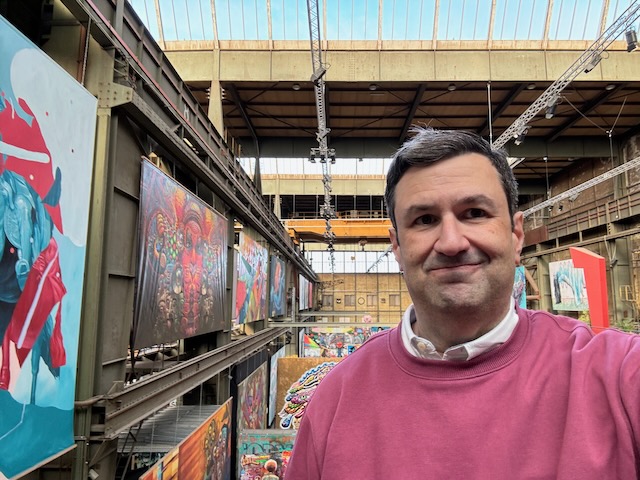This was my immediate reaction when I discovered there’s an entire museum in Amsterdam dedicated to street art and graffiti:

So, now that I’ve been to STRAAT, what did I think?1 I’m a bit conflicted.
On the plus side, STRAAT is undeniably a well-curated museum of the best work from the best artists on the planet. The collection was immense and incredible, featuring a wide range of styles and themes. The building (a converted shipbuilding facility) was roomy, uncrowded, and quiet, so I had plenty of time and space to reflect on the art.
One thing that stood out to me was the size of the art. Here’s how I measure up to a mural by Ox-Alien:

So, with so much to see and enjoy, why was I ambivalent? Ironically, the answer was right there in the STRAAT collection — this mural sums up everything I felt was problematic about the museum:

The Real Thing?
STRAAT is a zoo for street art. It’s an artificial, organized, viewer-friendly environment with an admission fee and a gift shop. It can’t replicate the experience of finding street art in the real world.
In the wild, no gatekeepers decide who gets to create art and whether it’s noteworthy. It’s integrated into its surroundings. Artists have to deal with constraints like space, time, weather, and the possibility their work will be tagged, replaced, or covered up by someone else.
Basically, the opposite of what happens in a museum.
Feral street art is meant to be discovered, devoured, and sometimes even destroyed. Museum street art is made to be displayed.
Consider these two murals by Cranio, a Brazilian artist who uses art to criticize how capitalism corrupts native values. The Complimentary Spouse and I saw this near Brick Lane in London in 2016:

And here’s the Cranio mural at STRAAT:

The mural at STRAAT is larger, more complex, and much easier to stand back and appreciate. But the mural in London is more meaningful and authentic because it’s there for everyone, not just those with the money and leisure time to visit a museum. Passersby will judge the work and its message on its own merits instead of being told by someone else that it’s A Very Important Piece of Art.
The feral mural is a statement. The museum mural is a statement piece.
I Have Come to Praise STRAAT, Not to Bury It
I don’t want to sound too dismissive about STRAAT. I enjoyed and appreciated my visit, and we must recognize the value of street art just as we would any other art form.2
STRAAT might be a zoo, but zoos play an important role in education and preservation.3 We need more places like STRAAT to validate, catalog, study, and share street art with the world.
The next time I visit a city with a street art museum, I’ll be first in line. But I’ll also look for street art where it was meant to be seen: the streets.
OK, I’m done opining. Let’s look at some more street art!
More STRAAT Photos





Very Colorful, Super Impressive, Easy to Like, Highly Detailed, People-Friendly Footnotes:
- I visited on October 13 during a business trip, so I got to share the experience with my colleagues (and expense the tickets). I always propose a street art-related outing for company meet-ups, and they are always a hit. ↩︎
- STRAAT has shifted my opinion of Wynwood Walls in Miami. Now that I’ve seen STRAAT, it’s easy to recognize that Wynwood Walls is pretty much the same thing without a roof. By elevating and drawing attention to street art, Wynwood Walls has attracted more artists to the area — a win-win for everybody. ↩︎
- And STRAAT doesn’t keep living beings in captivity, which is one of the things about zoos that really disturbs me. ↩︎

